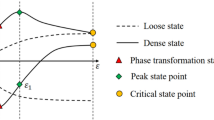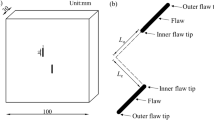Abstract
Presented is a study on the geometrical characteristics of sand particles and the mechanical behavior of sand material under external loading. Based on computed tomography technique, a reconstruction method of granular particles was developed and used to build a database of 3D geometrical models for sand particles. The studied sand particles showed good regularities in morphological characteristics and thus were suitable to be used for the random generation of numerical samples. DEM tests using realistically shaped particles were proven to better simulate the mechanical behavior of the sample during elastoplastic loading stage, which was an issue for the simplified spherical particles. The generation, extension, and breakage of the force chains controlled the strain softening behavior of sands. Anisotropy analysis using the spherical harmonic series showed that the evolution of anisotropy directions and parameters corresponded well with the macroscopic mechanical behavior of the material. Pore volume computation based on Voronoi diagram was performed to illustrate the formation and evolution of localized shear zone. The mesoscopic analysis showed that particle shape significantly influences the mechanical behavior of sands and thus should be properly modeled in numerical simulations.

















Similar content being viewed by others
References
Asahina D, Taylor MA (2011) Geometry of irregular particles: direct surface measurements by 3-D laser scanner. Powder Technol 213(1–3):70–78
Bagheri GH, Bonadonna C, Manzella I, Vonlanthen P (2015) On the characterization of size and shape of irregular particles. Powder Technol 270:141–153
Bagherzadeh-Khalkhali A, Mirghasemi AA (2009) Numerical and experimental direct shear tests for coarse-grained soils. Particuology 07(1):83–91
Casagrande A, Carillo N (1944) Shear failure of anisotropic materials. Proc Boston Soc Civ Eng 31:74–87
Charalampidou EM, Hall SA, Stanchits S, Lewis H, Viggiani G (2011) Characterization of shear and compaction bands in a porous sandstone deformed under triaxial compression. Tectonophysics 503(1–2):8–17
Cho N, Martin CD, Sego DC (2008) Development of a shear zone in brittle rock subjected to direct shear. Int J Rock Mech Min Sci 45(8):1335–1346
Feng ZK, Xu WJ, Lubbe R (2020) Three-dimensional morphological characteristics of particles in nature and its application for DEM simulation. Powder Technol 364:635–646
Govender N, Wilke DN, Kok S (2015) Collision detection of convex polyhedra on the NVIDIA GPU architecture for the discrete element method. Appl Math Comput 267:810–829
Guo N, Zhao J (2013) The signature of shear-induced anisotropy in granular media. Comput Geotech 47(1):1–15
Gupta R, Salager S, Wang K et al (2019) Open-source support toward validating and falsifying discrete mechanics models using synthetic granular materials-Part I: experimental tests with particles manufactured by a 3D printer. Acta Geotech 14:923–937
Hyslip JP, Vallejo LE (1997) Fractal analysis of the roughness and size distribution of granular materials. Eng Geol 48(3):231–244
Iwashita K, Oda M (1998) Rolling resistance at contacts in simulation of shear band development by DEM. J Eng Mech ASCE 124:285–292
Ishida T, Kanagawa T, Kanaori Y (2010) Source distribution of acoustic emissions during an in situ direct shear test: implications for an analog model of seismogenic faulting in an inhomogeneous rock mass. Eng Geol 110(3–4):66–76
Kozicki J, Donzé FV (2008) A new open-source software developed for numerical simulations using discrete modeling methods. Comput Methods Appl Mech Eng 197(49):4429–4443
Kozicki J, Donzé FV (2009) YADE-OPEN DEM: an open-source software using a discrete element method to simulate granular material. Eng Comput 26(7):786–805
Kruyt NP, Rothenburg L (2016) A micromechanical study of dilatancy of granular materials. J Mech Phys Solids 95:411–427
Kuhn MR (1999) Structured deformation in granular materials. Mech Mater 31(6):407–429
Lai Z, Chen Q (2019) Reconstructing granular particles from X-ray computed tomography using the TWS machine learning tool and the level set method. Acta Geotech 14:1–18
Li CQ, Xu WJ, Meng QS (2015) Multi-sphere approximation of real particles for DEM simulation based on a modified greedy heuristic algorithm. Powder Technol 286:478–487
Lin X, Ng TT (1997) A three-dimensional discrete element model using arrays of ellipsoids. Géotechnique 47(2):319–329
Luerkens D (1986) Particle surface morphologies—the three dimensional particle. Part Sci Technol 4(4):371–378
Mollon G, Zhao J (2012) Fourier–Voronoi-based generation of realistic samples for discrete modelling of granular materials. Granul Matter 14(5):621–638
Oyanguren PR, Nicieza CG, Fernández MIÁ, Palacio CG (2008) Stability analysis of Llerin Rockfill Dam: an in situ direct shear test. Eng Geol 100(3):120–130
Peters JF, Hopkins MA, Kala R, Wahl RE (2009) A poly-ellipsoid particle for non-spherical discrete element method. Eng Comput 26(6):645–657
Rechenmacher AL, Abedi A, Chupin O (2010) Evolution of force chains in shear bands in sand. Géotechnique 60(5):343–351
Reid K, Edward A, Gioacchino V et al (2016) Level set discrete element method for three-dimensional computations with triaxial case study. J Mech Phys Solids 91:1–13
Rothenburg L, Bathurst RJ (1993) Influence of particle eccentricity on micromechanical behavior of granular materials. Mech Mater 16(1):141–152
Salazar A, Sáez E, Pardo G (2015) Modeling the direct shear test of a coarse sand using the 3D discrete element method with a rolling friction model. Comput Geotech 67:83–93
Santamarina JC, Cho GC (2004) Soil behaviour: the role of particle shape. Proceedings of the skempton conference, March, London
Thornton C (2000) Numerical simulations of deviatoric shear deformation of granular media. Géotechnique 47(2):319–329
Ueng TS, Chen TJ (2000) Energy aspects of particle breakage in drained shear of sands. Geotechnique 50(1):65–72
Wang J, Dove JE, Gutierrez MS (2007) Discrete-continuum analysis of shear banding in the direct shear test. Géotechnique 57(6):513–526
Xiao Y, Liu H, Desai CS, Sun Y, Liu H (2016) Effect of intermediate principal-stress ratio on particle breakage of rockfill material. J Geotech Geoenviron Eng 142(4):06015017
Xiao Y, Long L, Matthew Evans T et al (2019) Effect of particle shape on stress–dilatancy responses of medium-dense sands. J Geotech Geoenviron Eng 145(2):04018105
Xu WJ, Xu Q, Hu RL (2011) Study on the shear strength of soil–rock mixture by large scale direct shear test. Int J Rock Mech Min Sci 48(8):1235–1247
Yang H, Xu WJ, Sun QC, Feng Y (2017) Study on the meso-structure development in direct shear tests of a granular material. Powder Technol 314(1):129–139
Yang J, Wei LM (2012) Collapse of loose sand with the addition of fines: the role of particle shape. Geotechnique 62(12):1111–1125
Zhang HY, Xu WJ, Yu YZ (2016) Triaxial tests of soil–rock mixtures with different rock block distributions. Soils Found 56(1):44–56
Zhang L, Thornton C (2007) A numerical examination of the direct shear test. Géotechnique 57(4):343–354
Zhao SW, Zhou XW, Liu WH (2015) Discrete element simulations of direct shear tests with particle angularity effect. Granul Matter 17:793–806
Zhao SW, Evans TM, Zhou XW (2018) Shear-induced anisotropy of granular materials with rolling resistance and particle shape effects. Int J Solids Struct 150:268–281
Zingg & Theodor (1935) Beitrag zur schotteranalyse. Mineral Petrol Mitt 15:39–140
Acknowledgements
The authors would like to acknowledge the project of “The National Key Research and Development Program of China, China (2017YFC0805406),” “Natural Science Foundation of China (51679123, 51879142),” “Research Fund Program of the State Key Laboratory of Hydroscience and Engineering (2020-KY-04).”
Author information
Authors and Affiliations
Corresponding author
Additional information
Publisher's Note
Springer Nature remains neutral with regard to jurisdictional claims in published maps and institutional affiliations.
Rights and permissions
About this article
Cite this article
Xu, WJ., Liu, GY. & Yang, H. Study on the mechanical behavior of sands using 3D discrete element method with realistic particle models. Acta Geotech. 15, 2813–2828 (2020). https://doi.org/10.1007/s11440-020-00982-0
Received:
Accepted:
Published:
Issue Date:
DOI: https://doi.org/10.1007/s11440-020-00982-0




